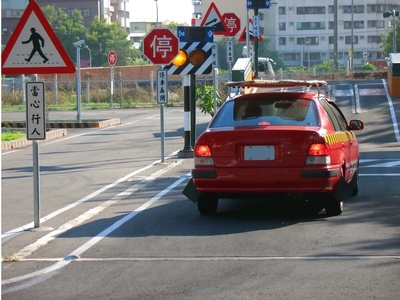
People who've prepared for a driver's test stand a better chance of passing the examination than people who rush into the process. Whether the test entails the motorcycle or automotive version, knowing the basics gives you a head start on what will be expected and why. The written and driving tests might seem tricky or confusing, but they've been designed to be exacting, simulating real responses, situations and road conditions. Simple preparation will help driver pass basic requirements.
A state's motor vehicle agency's licensing board will all have instruction handbooks that outline driving rules and safety. These handbooks, obtained at your local motor vehicle agency office, contain a wealth of information on everything you will need to know about traffic laws, vehicle regulations and driving safety. Reading the handbook cover to cover, taking notes and refreshing yourself just before the written exam gives you the advantage of knowing your subject well. It will increase your chances of passing the written exam rather than guessing at difficult questions.
For people who wish to see what an actual test might look like with sample questions and answers, tests can be found online that have similar questions dealing with typical scenarios that will be encountered on the real test. Online handbooks can also be downloaded for study use. Many practice sites have FAQ, or frequently asked questions, sections that most people should study before any test.

Student drivers (accompanied by a licensed driver) should have some actual driving experience in moderate to heavy traffic before applying for the physical driving test. Student drivers under 18 years old should present certificates to the driver's license testing office that indicate the numbers of hours required by their state for eligibility. Actually driving behind the wheel prepares the applicant for maneuvers that may be encountered or requested by the instructor.
The vehicle you bring to the test station must be registered and have up-to-date insurance from an accredited automobile insurance company. Safety items like seat belts, turn signals, brake lights, tires, engine operation, cooling system, steering and other safety-related vehicle components must be in proper working order. Instructors often perform inspections of the vehicle before the test begins.
Be on time for your scheduled appointment. No alcohol or drugs. Dress well with a nice groomed appearance. Secure your place in line and make sure a licensed driver has accompanied you and remains in the vehicle (driver's position) up until the time that the instructor greets you. You'll then display your identification documents to the instructor and await his approval of you and your vehicle. You can then assume the driver's position. Buckle your seat belt and adjust all mirrors.
Use hand signals in addition to electric turn signals, even though it might not be a cardinal rule for your testing purposes. It'll show extra effort. Always keep both hands on the steering wheel. Remember, too, to check your blind spot when merging into traffic or changing lanes.